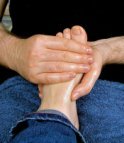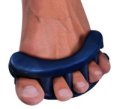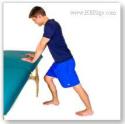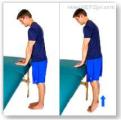There are a number of things that can help reduce the pain and frequency of foot cramps:

1) Massage: Massaging the affected area helps the muscles to relax, therefore reducing the symptoms of foot cramps. Massage works by increasing the circulation to the muscles, thereby increasing the blood flow, oxygen and nutrient levels as well as taking away harmful waste products such as lactic acid. You can reduce calf muscle cramps by massaging the muscles on the back of the calf from the ankle to the knee, and reduce toe and foot cramps by massaging the ball of the foot
2) Heat: applying heat either via a heat pad or warm water can help relax muscles, improve blood flow and reduce pain
3) Stretching: this is one of the best, short-term treatments for foot and calf muscle cramps. Gentle stretching at the time of the cramp helps alleviate symptoms, and regularly stretching helps prevent cramp from developing. See the stretches section for how to stretch the calf and foot muscles effectively. Always make sure pain in the muscle is from cramps, not from damage to the muscle as stretching a torn muscle could cause further injury
4) Balanced Diet: Eating a healthy, balanced diet helps ensure a correct balance of vitamins and minerals to allow proper functioning of nerves and muscles. Cramp due to poor diet can be rectified in just a few days
5) Increase water intake: helps prevent dehydration. This is especially important in hot weather or if exercising lots
6) Appropriate Footwear: make sure you are wearing suitable shoes when exercising that fit well and support your feet. Reduce foot and toe cramps by steering clear of high heels or shoes with a narrow toe box everyday – keep them for special occasions
7) Exercise Appropriately: whilst it is important to exercise regularly, exercising too much or too vigorously is not advisable. Always warm up and cool down before and after exercise. If you are new to exercise, start slowly and gradually build up the intensity so as not to overload your body. If sitting for long periods, keep your feet moving by circling your ankles to improve circulation to your feet
8) Strengthening Exercises: improving the strength of the foot muscle can reduce the chances of toe cramps e.g. practice picking up marbles with your toes. Reduce the risk of calf muscle cramps by repeatedly rising up on your tip toes to strengthen your calf muscles. Visit the Calf Workout section for a whole range of exercises to strengthen the calf muscles.
9) Supplements: blood tests may indicate a deficiency of some vitamins and/or minerals in which case taking supplements can help. Always check with your doctor before taking any supplements, as they may have harmful side effects.

10) Toe Stretchers: many people find that wearing toe stretchers for an hour or so each day reduces the frequency of foot cramps. They help to stretch out the muscles and ligaments around the toes, and improve the alignment of the bones. Find out more in the Toe Stretchers section including user reviews.
When to See Your Doctor
In most cases, foot cramps are not serious and are rarely a medical emergency. But sometimes, they can be a sign of an underlying medical condition. Achilles Podiatry is the Foot and Ankle Specialist of Indiana and If you believe you may be experiencing cramping of your feet or toes, contact Achilles Podiatry for further evaluation and treatment.
Source: Foot Pain Explored



